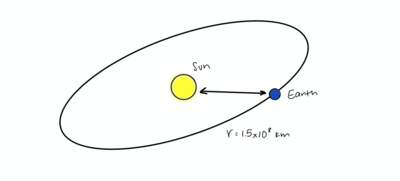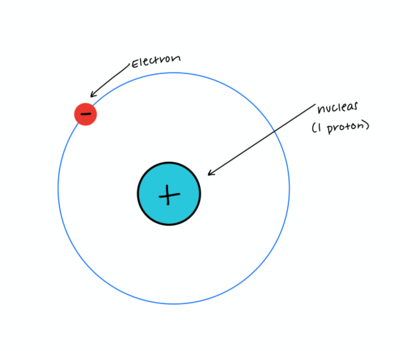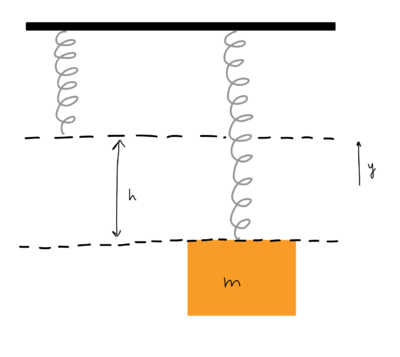Potential Energy of a Multiparticle System
The Main Idea
Imagine you drop a ball with a mass of [math]\displaystyle{ m }[/math] near the surface of the earth at the height of [math]\displaystyle{ h }[/math]. If the ball alone is considered to be the system, i.e., the Earth is the surrounding, it is straightforward to find that the kinetic energy of the system (ball) increases, due to the positive work done on the ball by the Earth. In other words, as the gravitational force acts in the same direction as the displacement of the ball, the work done by the surroundings (the Earth) is equal to [math]\displaystyle{ mgh }[/math].
What if you choose the system to contain both the ball and the Earth? In this case, nothing is significant in the surroundings to exert any work on the system. As a result,
[math]\displaystyle{ \Delta K_{sys} = W_{surr} }[/math] => [math]\displaystyle{ \Delta K_{ball} + \Delta K_{earth} = 0 }[/math]
However, it is quite apparent from the experimental observation that the kinetic energy of the ball increased since it acquired speed when dropping, and that the kinetic energy of the Earth also increased in a small amount since the gravitational force between the ball and the Earth drew the Earth towards the ball. In other words, the experimental observation indicates that [math]\displaystyle{ \Delta K_{ball} \gt 0 }[/math] and [math]\displaystyle{ \Delta K_{earth} \gt 0 }[/math]. This seems to introduce a conflict between a real-world experiment and a fundamental principle in Physics, where the experiment indicates that the kinetic energy of the two-body system (ball + Earth) increased, while the energy principle states that the energy change of the system be zero since no significant work is done by the surroundings on the system. This can't be correct! One may decide that the fundamental Energy Principle has been violated. But wait! Is it possible that some energy component is overlooked during this process?
In fact, some energy component is missing from the energy principle for systems that contain more than one interacting object: the potential energy, commonly designated as [math]\displaystyle{ U }[/math]. In particular, any system that consists of more than one particle (multiparticle systems) such as the ball-Earth system, compressed/stretched springs, or atoms in which protons and electrons interact electrically, have a type of energy that is associated with the interactions between pairs of particles inside the system. In the ball-Earth system, it is associated with the interaction between the ball and the Earth, and it is different from the rest energies of the ball or the Earth, and different from the kinetic energies of the two individual particles. This specific type of pairwise interaction energy is referred to as potential energy for multiparticle systems. For this ball-Earth system consisting of the ball and the Earth interacting with each other, the total energy change is in fact:
[math]\displaystyle{ \Delta m_{ball}c^2 + \Delta m_{Earth}c^2 + \Delta K_{ball} + \Delta K_{earth} + \Delta U_{ball-Earth} = 0 }[/math]
As the identities of the two particles do not change, [math]\displaystyle{ \Delta m_{ball}c^2 = 0 }[/math] and [math]\displaystyle{ \Delta m_{Earth}c^2 }[/math]. As a result,
[math]\displaystyle{ \Delta K_{ball} + \Delta K_{earth} + \Delta U_{ball-Earth} = 0 }[/math]
A Mathematical Model
How do we calculate the potential energy in a multiparticle system? There are three major types of potential energies that are commonly discussed in real-world multiparticle systems.
Gravitational Potential Energy: In general, in a system containing more than one particles constantly interacting with each other pairwise via gravitational force such as the Sun and the Earth as in the following figure, the potential energy at any moment between any two interacting particles with a distance [math]\displaystyle{ r }[/math] can be calculated as:
[math]\displaystyle{ U = -G\frac{mM}{r} }[/math]
where [math]\displaystyle{ m }[/math] and [math]\displaystyle{ M }[/math] are the masses of the two particles, respectively, and [math]\displaystyle{ G }[/math] is the gravitational constant, [math]\displaystyle{ 6.7 × 10^{−11} N · m^2/kg^2 }[/math]. In the ball-Earth system, where the ball with a mass of [math]\displaystyle{ m }[/math] is falling near the surface of the Earth of the height of [math]\displaystyle{ h }[/math], the gravitational potential energy can be simplified as [math]\displaystyle{ mgh }[/math].
Electric Potential Energy: In a system containing more than one charged particles interacting with each other pairwise electrically such as the protons and the electrons in an atom, the potential energy at any moment between any two charged particle interacting with each other with a distance [math]\displaystyle{ r }[/math] can be calculated as:
[math]\displaystyle{ U = \frac{1}{4\pi\epsilon_0}\frac{q_1q_2}{r} }[/math]
where [math]\displaystyle{ \frac{1}{4\pi\epsilon_0} }[/math] is the electric constant, [math]\displaystyle{ 9 × 10^9 N · m^2/C^2 }[/math], and [math]\displaystyle{ q_1 }[/math], [math]\displaystyle{ q_2 }[/math] represent the amount of charges on the two interacting particles (measured in [math]\displaystyle{ C }[/math]). Note that unlike the gravitational potential energy, the electric potential energy can have either negative or positive value. If the two charges have opposite signs, the potential energy between the two interactive charged particles is negative. Otherwise, the potential energy is positive.
Spring Potential Energy: In a multiparticle system as shown in the following figure in which consists of a spring and other particles such as a ball detached to one end of the spring, the potential energy of the system can be calculated as
[math]\displaystyle{ U = \frac{1}{2}k_sh^2 }[/math]
where [math]\displaystyle{ k_s }[/math] represents the spring constant and [math]\displaystyle{ h }[/math] is the stretch of the spring.
A Computational Model
The following is a code segment to compute the spring potential energy, gravitational energy, and the total energy of a spring-ball multiparticle system in which one end of the spring is attached to the ceiling and the other end is attached to a ball.
L=ball.pos-ceiling.pos
s=mag(L)-L0
unitL=L/mag(L)
Fspring=-ks*s*unitL
Fgrav=mball*g*vector(0,-1,0)
## calculate net force on ball (note: has two contributions)
Fnet = Fspring + Fgrav
## apply momentum principle
ball.p=ball.p+Fnet*deltat
## update position
ball.pos=ball.pos+ball.p/mball * deltat
## update axis of spring
spring.axis=ball.pos-ceiling.pos
# kinetic energy of the ball
ball.v = ball.p / mball
K_ball = 0.5 * mball * (mag(ball.v))**2
# potential energy of spring
U_ball = 0.5 * ks * s**2
# potential energy of gravity
U_gravity = mball*g*ball.pos.y
# total energy
E_tot = K_ball + U_ball + U_gravity
# plot energy graphs
U_graph.plot(pos=(t,U_ball + U_gravity)) #Potential energy as a function of time
K_graph.plot(pos=(t,K_ball)) #Kinetic energy as a function of time
Energy_graph.plot(pos=(t,E_tot)) #Total energy as a function of time
Examples
Refer to the above section for detailed examples to compute potential energies for a multiparticle system in different contexts.
Connectedness
Potential energy is an important form of energy but overlooked sometimes. Understanding the significant of the potential energy gives me a clear understanding of real-world systems such as the ball-Earth system. Also, another important application is the spring potential energy which is prevalent in any systems that involves the use of spring.
See also
If you haven't read this wiki page, you should check it [1] out. Also, this is another related article [2] that has detailed examples and explanations on how to compute the potential energies in different systems.
Further reading
The book Matter & Interactions by Ruth W. Chabay and Bruce A. Sherwood provides a nice reading on this topic [3].
External links
Related discussion topics from University of Oregon [4].
A very nice video from Khan academic [5].
Another short video by Bozeman Science [6].
References
http://shaikhshahin.blogspot.com/2015_09_01_archive.html
https://www.youtube.com/watch?v=8a4D2xqHBF4


